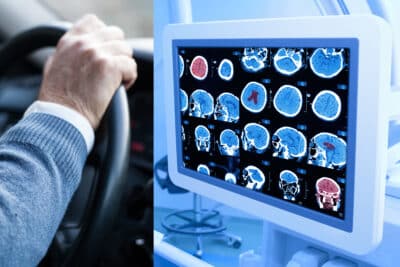 The Medical Imaging Center at Semmelweis University shared on its social media page the cranial scan of one of the most severe recent cases. The CT image shows the skull of a patient with skull base and temporal bone fractures who underwent multiple surgeries. The scan was performed with a so-called photon-counting CT scanner, which produces higher-resolution and more detailed images than conventional devices. This scanner was among the first of its kind to be put into operation worldwide. In Hungary, there are currently two such scanners, both in service at the Medical Imaging Center of Semmelweis University.
The Medical Imaging Center at Semmelweis University shared on its social media page the cranial scan of one of the most severe recent cases. The CT image shows the skull of a patient with skull base and temporal bone fractures who underwent multiple surgeries. The scan was performed with a so-called photon-counting CT scanner, which produces higher-resolution and more detailed images than conventional devices. This scanner was among the first of its kind to be put into operation worldwide. In Hungary, there are currently two such scanners, both in service at the Medical Imaging Center of Semmelweis University.
“From a radiological perspective, e-scooter accidents are characterized by novel injury patterns. In minor bicycle accidents the ‘classic’ wrist fractures, nasal bone fractures, and non-displaced skull fractures are common, whereas in e-scooter accidents,comminuted fractures and complex traumas are much more frequent” – said Dr. Péter Hegedűs, Deputy Director of the Medical Imaging Center.
According to data from the Central Statistical Office, there were 367 accidents caused by e-scooters in Hungary in 2024. In the first half of 2024, 166 such accidents were recorded, while in the same period of 2025 the number rose to 253 – an increase of more than 50 percent in just one year. Source
Because of its small wheels, an e-scooter can easily fall over if the rider hits a hole or a pothole. In such cases, the rider usually falls over the handlebars, and if they are not wearing a helmet or other protective equipment, they will almost certainly get injured. According to the Department of Traumatology at Semmelweis University, this summer at least one – and sometimes two or more – injured patients were treated each day, most commonly with head and limb injuries.
 About three quarters of these e-scooter accidents result in skull injuries, and 10–20 percent of those cases are serious, significant intracranial injuries. Among other minor, superficial injuries, maxillofacial injuries are also common, and in high-speed accidents internal injuries in the thoracic or abdominal cavities may also occur – although fortunately these are less frequent,” said Dr. Tamás Bodzay, Director of the Department of Traumatology.
About three quarters of these e-scooter accidents result in skull injuries, and 10–20 percent of those cases are serious, significant intracranial injuries. Among other minor, superficial injuries, maxillofacial injuries are also common, and in high-speed accidents internal injuries in the thoracic or abdominal cavities may also occur – although fortunately these are less frequent,” said Dr. Tamás Bodzay, Director of the Department of Traumatology.
It is common in e-scooter accidents that the rider falls on their chin and suffers a jaw fracture. According to experience, this happens either because the rider is traveling at high speed and has no time to break the fall, or because their reflexes are dulled under the influence of psychoactive substances. This is similar to small children, who often fall on their faces until their protective reflex develops.
In the United Kingdom, there were 460 e-scooter accidents in 2020, in which 1 person died and 483 were injured. By 2024, the number of accidents had risen to 1,312, with 6 deaths and 1,384 injuries. Source 1, Source 2
In these cases, the condylar heads of the mandible are typically affected. If the fractured ends are not properly stabilized during healing, this can result in limited mouth opening and temporomandibular joint problems. When only the condylar heads are involved, patients often fail to recognize the injury as particularly serious.
 “Many people think that a fracture only counts as such if it is visible – for example, when the two fractured ends pierce through the skin or when the bones are clearly in an abnormal position. However, jaw fractures are sometimes not externally visible, leading patients to believe medical attention is unnecessary. Even when they do recognize the injury, many delay treatment until the following day rather than seeking prompt care. Yet, for optimal healing, these fractures should be treated and surgically fixed within 48 to 72 hours,” said Dr. Petra Papócsi, specialist at the Department of Oro-Maxillofacial Surgery and Stomatology, Semmelweis University.
“Many people think that a fracture only counts as such if it is visible – for example, when the two fractured ends pierce through the skin or when the bones are clearly in an abnormal position. However, jaw fractures are sometimes not externally visible, leading patients to believe medical attention is unnecessary. Even when they do recognize the injury, many delay treatment until the following day rather than seeking prompt care. Yet, for optimal healing, these fractures should be treated and surgically fixed within 48 to 72 hours,” said Dr. Petra Papócsi, specialist at the Department of Oro-Maxillofacial Surgery and Stomatology, Semmelweis University.
In Germany, there were 2,155 e-scooter accidents in 2020, resulting in 5 deaths and 2,293 injuries.
In 2024, the number of accidents reached 11,944, with a total of 27 deaths and 12,946 injuries.
Source 1, Source 2
E-scooter accidents mostly happen at night. The severity of the accident is influenced by factors such as whether the rider has consumed alcohol or drugs, the speed at which they fell, and whether they were wearing a helmet or other protective equipment.
To help avoid severe or even fatal e-scooter accidents, the Medical Imaging Center issued safety recommendations alongside the CT scan it published on social media.
Photos: Boglárka Zellei, Bálint Barta – Semmelweis University; Cover/illustration: Medical Imaging Center Facebook


